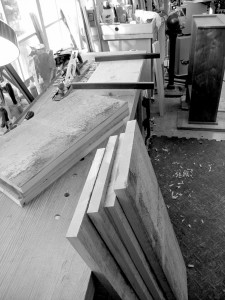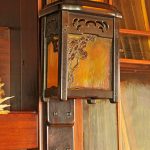We may receive a commission when you use our affiliate links. However, this does not impact our recommendations.
I’ve seen a lot of vintage tool chests in my travels, and most of them have been made of pine. What kind of pine? Hard to say. Most pines look the same when they are covered in paint, dirt, grease and what looks like monkey dung.
But pine is not the only wood appropriate for a tool chest.
When you set out to choose a wood species, it’s best not to be dogmatic about the genus and instead try to get into the mindset of the pre-Industrial chest builder. Did they pick pine because it was anointed with the magical juices of Care Bear glands? Probably not.
Instead, pine was cheap, lightweight, widely available and strong enough for a tool chest.
So those are the same guidelines I would recommend you follow when picking a species for your tool chest. Eastern white pine (Pinus strobus) is readily available only in a small section of North America. Is it awesome? Yes. Should you break your bank account trying to get it? Absolutely not.
I recommend you try to find any species that fits the above criteria. In most of North America, tulip poplar is an excellent choice for a tool chest. It is dirt cheap, available in wide widths and has a face for a paint brush (if you know what I’m saying).
Other pines would be suitable for a tool chest. Sugar pine is a good choice. In some parts of the United States (such as where I live) we are lousy with walnut. In the western states, take a look at alder. Heck, even basswood is strong enough for a tool chest.
What species should you avoid? Heavy woods (maple, yellow pine, insane exotics), ring-porous woods that are difficult to dovetail (ash and the oaks), pines that crumble (radiata). But despite that last sentence, I’ve seen fantastic tool chests made using all those species and they can do the job. But they wouldn’t be my first choice for a chest wood.
Bottom line: Don’t let the species of woods available in your area force you into making a crazy decision, such as buying Eastern white pine for $8 a board foot. Instead, look around you. Look to the skies – and I mean that literally. What trees are in your backyard?
— Christopher Schwarz
If you want to learn about the other specifications for a good tool chest, check out my latest book, “The Anarchist’s Tool Chest,” available in Shopwoodworking.com with free shipping.
Here are some supplies and tools we find essential in our everyday work around the shop. We may receive a commission from sales referred by our links; however, we have carefully selected these products for their usefulness and quality.









Chris
I’m curious about your remark that oak is difficult to dovetail. I just built a bedroom suite for my grandson and used red oak for the drawer boxes; all hand cut dove tails. Also, my Pennsylvania House cherrry bedroom set uses red oak for the drawer boxes; machine cut of course. I’ve made drawers from poplar, cedar and birch previously, but I prefer oak. I haven’t given it a lot of thought until now, but on reflection, I think it’s because of the way it responds to a sharp chisel; it cuts cleanly. Also, it is so tough that it doesn’t split if you have to use a little extra persuasion when assembling the joint.
I have built two nice tool chests one for my brother and one for me. I made one using recycled furniture parts of riff sawn white oak and the other out of a mulberry boards that I had sawn from a tree that was felled by one of my neighbors. The white oak was very stable to work with because of its age and when stained really turned out quite well and the other I was able to book match some nice grain (very wide in mulberry) and watch it turn from a yellow to a brown as it aged. Both were you might say “locally available woods” and were obtained at a minimal cost.
Marc Woods
Is Bald Cyress a good wood to use for a tool chest?
I’m gonna cast my vote for walnut, if you can get it cheap. In retrospect, I’d also probably go a little thinner like 3/4 vs. 7/8 thick since it’s denser than pine.
What do mean that radiata pine ‘crumbles’?
I came across a bunch of quarter and rift sawn Douglas Fir, all of which is over 60years old and really really dry. I not only used this stock for my bench top but I am going to be making most of my tool chest out of it. I have a little sugar pine for the drawers and for the bottom of the chest. I know the DF is heavier but I also don’t plan on carrying this chest around. just pushing it around on wheels in my small shop.
I can’t throw a rock without hitting a redwood, but that seems a little soft to me. I’ll have to try some experimental dovetails. (all of my dovetails are pretty much experimental though)
What species is the squishy soft white pine they sell in the big box stores?
The reason so much what we now call antique furniture was made with pine is because the early settlers used the hard wood for fuel. You have to remember that they had to cut a lot of firewood for those uninsulated homes and hardwood gave them more BTU’s so they made furniture with pine and heated with hard woods.
I’ve got an apple tree and a lilac tree. Oh, and highbush cranberry and honeysuckle. Ever see a tool chest made out of honeysuckle?
“What trees are in your backyard?”
Next up at LAP, “Sweet Revenge: Make a tool chest from that tree that’s always clogging the gutters and raining sap on your car”? 🙂
I considered alder, being a local wood to me. But it can either be a bargain or fairly expensive, depending on the source and quality. I ended up using a western yellow pine, probably ponderosa. Yeah it’s heavy, but cheap; about $1/bf.